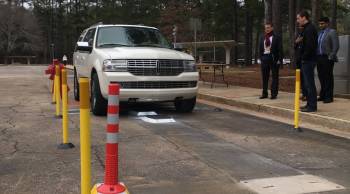Tracking drug smugglers on interstate highways
Kai Ryssdal: The bio-pharmacological benefits of Miracle-Gro on domestic medical marijuana crops aside, a good portion of the illegal drugs in this country come over the Mexican border. Once they get here, the first stop is usually a stash house someplace, in a city like Phoenix or San Diego. Smugglers then pick up smaller loads for wider delivery and they have a convenient pipeline — the interstate highway system.
Today we continue our series, “The Drug War at Home,” from Fronteras — a regional reporting project in the Southwest. Jude Joffe-Block reports on the hunt for illegal drugs on American highways.
Jude Joffe-Block: Lt. Lazaro Chavez oversees a team that intercepts drugs smuggled in from Mexico. But Chavez isn’t anywhere near the border. He works 300 miles away, for the Las Vegas Metro Police Department.
Lazaro Chavez: This is the battleground for us, right here, Interstate 15.
I-I5 starts in San Diego, passes by the Mojave Desert, through Las Vegas, and onto Salt Lake City where it heads north.
Chavez: This is the road that the cartels have identified as their route.
The federal government chips in $3 million annually to fight drugs in Southern Nevada. It’s one of 28 zones throughout the country that get federal support as so-called High Intensity Drug Trafficking Areas.
Chavez and his team drive unmarked cars.
Chavez: It is almost like a big chess game. So we figure out, how are they doing it today? Are they using a semi? Are they using buses? Maybe they are using hidden compartments inside cars.
Various law enforcement agencies share intelligence, which helps Chavez and his team track down suspicious vehicles. They also look out for models known to have good hiding spots for drugs. One example? Behind the dashboard of the newer Volkswagen Beetle. But the only constant in this game is that the traffickers’ techniques are always advancing.
Chavez: They are putting forth every effort that they can to train their drivers, to provide them with security vehicles to escort them through the United States.
You’d think the price for drugs would go up the farther they travel. That is true for marijuana. But the most expensive drugs — cocaine, heroin and methamphetamine — aren’t like typical cargo. Take cocaine, which could be worth around $6,000 per pound at the wholesale price.
Jonathan Caulkins: It’s very hard to think of any other normal commodity that costs anywhere near that much per unit weight.
Professor Jonathan Caulkins researches drug markets at Carnegie Mellon University. He points out that $300,000 worth of cocaine at wholesale price can fit in just a 50-pound suitcase.
Caulkins: So if you had two people spend a week driving that cocaine from the Southwest border all the way to New York City, still the cost of labor, the cost of gasoline — they are really [a] round-off error.
Of course there is the risk of being caught. But Caulkins says drug traffickers calculate the real risky part to be the sale, not the drive. Each transaction is a chance to be busted by the cops or robbed, and that drives up the price. Caulkins says that’s why the street price of cocaine can be eight times the wholesale price.

Drug seizures in 2009 by HIDTA in the region. (Illustration by Jude Joffe-Block. Source: HIDTA)
Caulkins: You see big differences in the price as a function of the number of transactions since the drugs entered the country, but there aren’t big differences as a function just of the number of miles away from the border.
From law enforcement’s perspective, they want to intercept those drugs as early as possible in the chain — before the loads have been divvied up.
Kent Bitsko: Once it gets to its location, you’re not going to get it all.
Kent Bitsko directs Nevada’s High Intensity Drug Trafficking Area taskforce. But he says if they do find drugs in a car, it’s becoming less common for the drivers to cooperate and become informants.
Bitsko: They’re not very willing to talk because they are afraid of the cartels. They are a lot more afraid of what will happen to them if they cross the cartels than what will happen to them going to prison here.
Those informants are key to dismantling drug trafficking organizations. And right now, the traffickers seem to be succeeding. They’re still able to get their product to consumers and make money.
Back on the highway, Lt. Chavez says he takes it personally when he finds out about large loads of drugs that make it into the city.
Chavez: You find 50 pounds or 100 pounds of methamphetamine, and you know that there is only one way it could have gotten here.
And that is on the highway, probably on Interstate 15.
In Las Vegas, I’m Jude Joffe-Block for Marketplace.
Ryssdal: Tomorrow in part three of our series — 22 million Americans use illegal drugs every year. How much blame do they deserve for the Mexican drug wars?
There’s a lot happening in the world. Through it all, Marketplace is here for you.
You rely on Marketplace to break down the world’s events and tell you how it affects you in a fact-based, approachable way. We rely on your financial support to keep making that possible.
Your donation today powers the independent journalism that you rely on. For just $5/month, you can help sustain Marketplace so we can keep reporting on the things that matter to you.


















